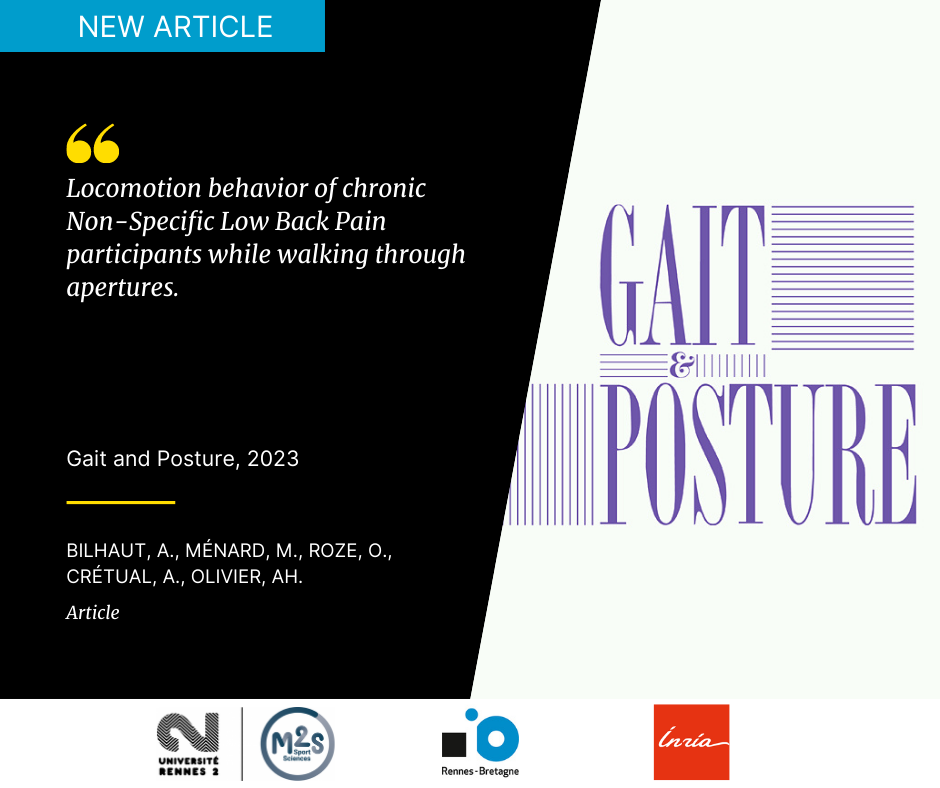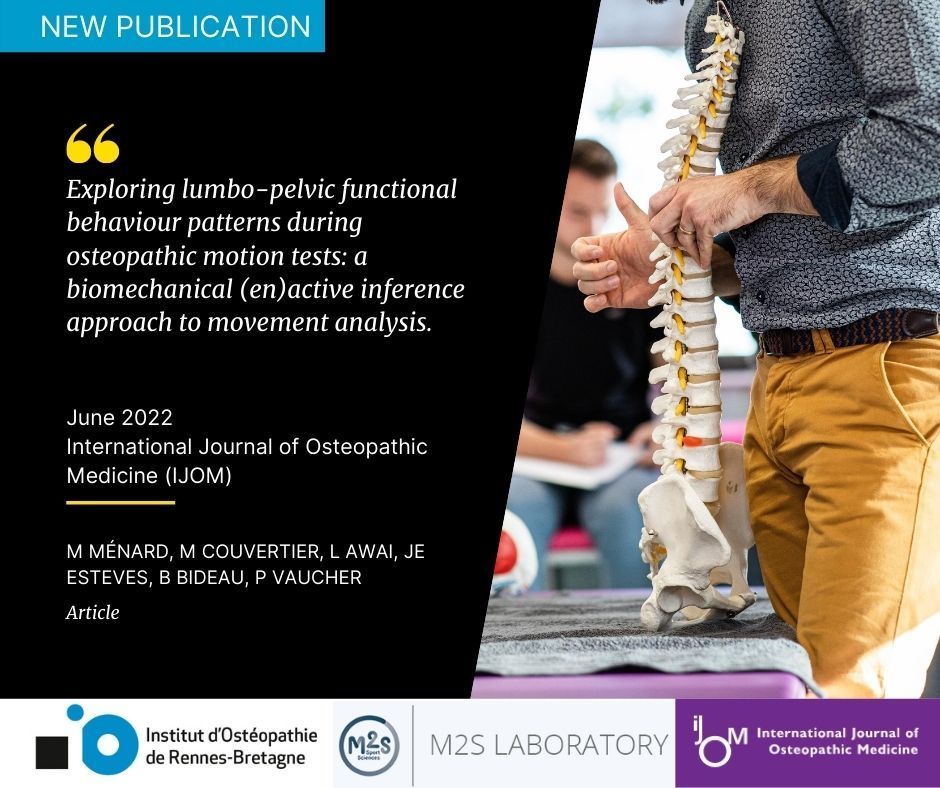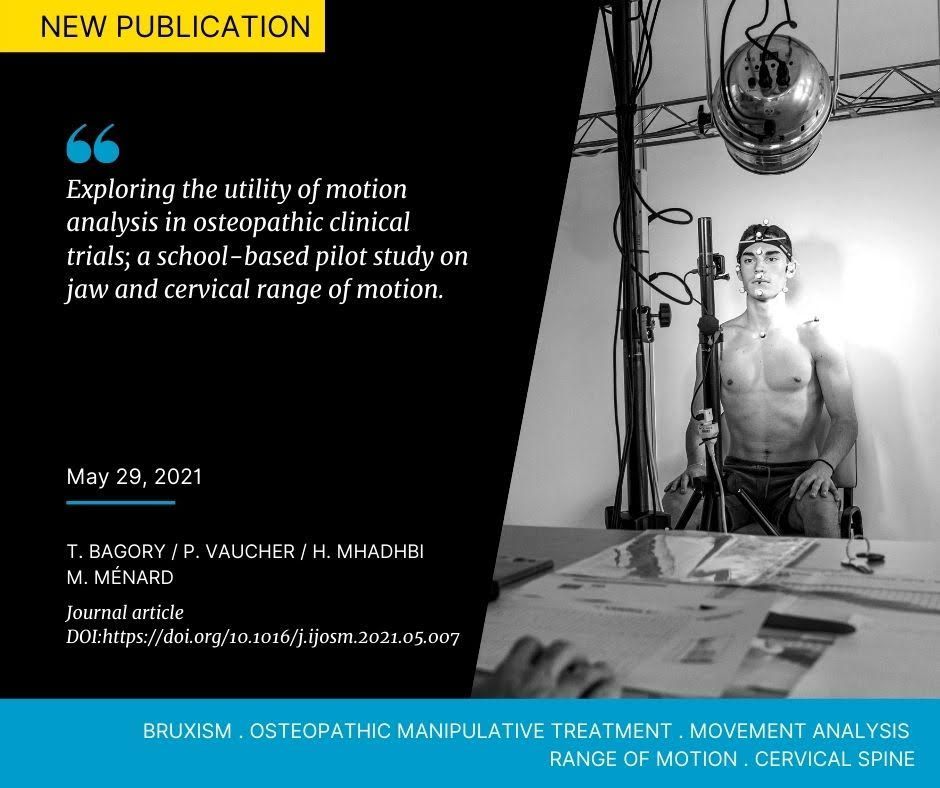Applied Biomechanics research project in Osteopathy

Osteopathic research is raising essential questions for the profession in France and abroad. The institute faces the challenge of evaluating new ways to assess non-medicinal interventions like osteopathic treatment. This line of research looks at new ways of making sense of traditional clinical tests used in practice. Students and staff work on many research projects together with the M2S laboratory at Rennes 2 University.

Projects and publications of the Institut d'Ostéopathie de Rennes-Bretagne
Locomotion behavior of chronic Non-Specific Low Back Pain participants while walking through apertures
Chronic Non-Specific Low Back Pain (cNSLBP) has been identified as one of the leading global causes of disability and is characterized by symptoms without clear patho-anatomical origin. The majority of clinical trials assess cNSLBP using scales or questionnaires, reporting an influence of cognitive, emotional and behavioral factors. However, few studies have explored the effect of chronic pain in daily life tasks such as walking and avoiding obstacles, which involves perceptual-motor processes to interact with the environment. Are action strategies in a horizontal aperture crossing paradigm affected by cNSLBP and which factors influence these decisions ?

Exploring lumbo-pelvic functional behaviour patterns during osteopathic motion tests: a biomechanical (en)active inference approach to movement analysis
Observing how individuals actively adapt to their environment may provide additional insights into traditional clinical tests. Rather than using tests that only identify joint mobility limitations, it seems relevant to use clinical motion tests that assess global biomechanical functions more generally and identify functional behaviours. This study explores whether different functional kinematic behaviour patterns appear when executing a new complex motor task and whether those observations are consistent over multiple executions.Marker-based kinematic analyses of the lumbo-pelvic complex were conducted on 29 asymptomatic athletes during two active self-induced motion tests: the one-sided tilt test and a modified version of this test limiting the trunk axial rotation.
Marker data served as an input for a full musculoskeletal model to compute the lumbar and lower limb joint angles. Latent class analysis and intraclass correlation coefficients were calculated to identify different classes of functional kinematic behaviour and assess the reliability between measurements. The methodology allowed us to identify four distinctive classes of possible movement combinations based on these two functional tests: standard movement, low knee and lumbar engagement, high pelvis engagement and high lumbar flexion.
All ICCs for the lumbo-pelvic complex degrees of freedom were higher than 0.6, suggesting a moderate to good reliability for the overall test. It remains unknown whether the observed reproducible patterns emerging from the motion test relate to motivation and prior experiences.
Further explorations are required to investigate whether these behaviours can be correlated to empirical clinical observations, past experiences, and future vulnerabilities for musculoskeletal conditions.

Exploring the Utility of Motion Analysis in Osteopathic Clinical Trials; a School-Based Pilot Study on Jaw and Cervical Range of Motion
This study explores the interest of using motion analysis to evaluate cervical and jaw ROM on students with or without bruxism when comparing Osteopathic manipulative treatment (OMT) to sham in school settings.
A feasibility study was run with 48 volunteer students from an osteopathic training institution. Random sequence for allocation was generated using a 1:1 ratio and block size of four to either OMT or sham treatment (control group). The chosen motion outcomes of interest were the lateral jaw range of motion, jaw opening, cervical rotation and side-bending.
ROM was measured averaging over three repeated movements at baseline, immediately after the 1st treatment, one week before the 2nd treatment, and immediately after second treatment using video-based analysis with 15 body landmarks. Repeated measures of joint motion at baseline showed high levels of reliability (ICC ranging from 0.953 to 0.985). Motion analysis detected clinically important differences between OMT and sham one-week post-treatment for jaw lateral ROM (3.3°; p=0.018) and cervical rotation ROM (12.0°; p=0.003) on participants with bruxism but not on those without. Magnitude of differences were increased for all parameters following the second treatment (lateral jaw movement; 4.8°, p=0.005; jaw opening; 5.5°, p=0.002; cervical side-bending; 9.2°, p=0.023; cervical rotation; 18.2°, p<0.001).
Motion analysis is capable of detecting the effects of OMT on cervical and jaw ROM in students with bruxism but not without. Finally, the study showed the feasibility of introducing usual standards for clinical trials and sham treatment in school led studies with students.





